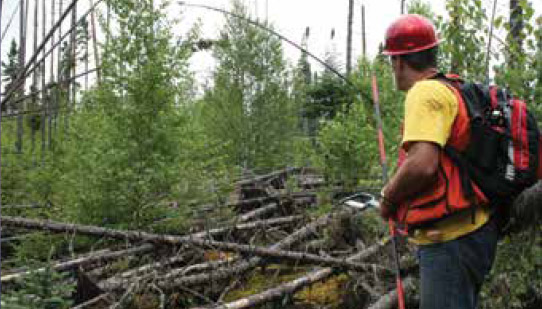Archived content
The information on this page is archived and provided for reference. It has not been altered or updated since first being published in the 2022 edition of the State of Canada’s Forests: Annual Report.
Wildland fires are a natural disturbance that contribute to regenerating and maintaining healthy, diverse forest ecosystems. However, Canada is experiencing longer wildland fire seasons and more frequent and extreme fire behaviour, placing growing risks on communities, critical infrastructure, economies, people’s health and safety, and long-term forest health. Since the 1970s, the average area burned annually has doubled, and wildfire experts predict that number will double again by the end of the century. Modelling also suggests that overall fire occurrence will increase as much as 75% by 2100.
Several combining factors are driving changes in wildland fire risk and behaviour. These include historic fire suppression approaches (which interrupted the natural restorative function of wildfire); the exclusion of Indigenous cultural burning (for millennia Indigenous Peoples used fire for landscape management); the growth of the wildland urban interface (more people, activities and assets located in forested areas); and climate change (warmer temperatures, fluctuating precipitation levels, and drier forest conditions).
Current and anticipated growth in wildland fire activity, in combination with other natural disturbances in the forest (such as pest infestations), impact carbon emissions. This includes direct emissions of greenhouse gases (GHG) and particulates, delayed emissions as fire-killed trees decompose, and reductions in overall carbon uptake (because dead trees are no longer able to absorb carbon from the atmosphere). Since the mid-2000s, natural disturbance-related emissions have generally increased but the emissions vary greatly between years, based on annual area burned. In Canada, annual carbon emissions from wildland fires alone can equal the annual total carbon emissions from burning fossil fuels across the country.
Monitoring wildland fires
Canada’s new WildFireSat Mission, a $230-million initiative announced in February 2022, will be the world’s first fully dedicated wildfire monitoring satellite system. It will work to provide detailed near-immediate fire analysis directly to those fighting fires on the ground. The system will also allow Canada to better measure carbon emitted by wildland fires.
Wildfire occurrence is monitored across the country using a variety of methods including aerial surveys (small airplanes, watchtowers) and weather mapping. A great deal of work also takes place to project where wildland fires may occur. Researchers use statistical, simulation and climate models to assess the areas most likely to experience a fire or to predict how a fire may behave under certain conditions. The resulting data provide a better understanding of how wildfires ignite, spread and behave, and how these factors are changing over time and under climate change.
Remote sensing (satellites) is also used to track and report both wildland fire and carbon emissions. Satellite imagery is an important input in Canada’s National Burned Area Composite (NABC), which is a geographic information system (GIS) that uses data to measure the area of forest burned nationally every year. This information helps estimate annual carbon emissions from wildland fire and contributes to assessments in the National Inventory Report to support Canada’s international GHG reporting requirements.
More fire on the landscape: How to adapt?

Climate change is transitioning Canada into a different relationship with wildland fire. What is now considered extreme seasonal fire activity will become increasingly common. To adapt to these changes, it is critical to understand how and why they are happening and what needs to be done to prevent the risk or severity of future fires. Data, science, and other ways of knowing will improve the ways Canada manages for wildland fire and help mitigate the release of CO2 emissions from large fire events.
Long-term solutions include pro-active forest and fire management approaches such as reducing fuels available to burn (tree thinning, conducting planned burns, removing deadwood); planting fire-tolerant tree species; creating more fire breaks to reduce area burned and fire severity; and expanding best practices, such as the FireSmart™ Canada program, to proactively mitigate risk to communities and forest-based infrastructure.